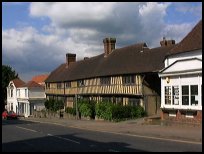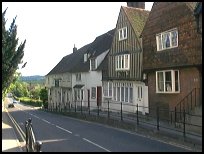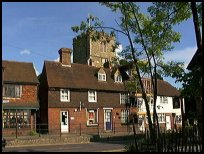| |

|
|
|
| |
 Staplehurst in Kent lies on the A229 Maidstone to Hawkhurst road, this
stretch is Roman and lead from Beauport near Battle to Rochester. Staplehurst in Kent lies on the A229 Maidstone to Hawkhurst road, this
stretch is Roman and lead from Beauport near Battle to Rochester.
The name is derived from the Saxon a Staple meaning Post and hurst
a wood.
The church was built around 1150 and attracted a few people who
were either farmers or foresters.
In 1331 the export of unwashed wool was prohibited by King Edward III .
He encouraged weavers from Flanders to settle at nearby Cranbrook
where they proceeded to teach the English to turn wool into
broadcloth. The weavers spread all around the area and some
settled in Staplehurst , the wealth from this industry
can be seen in the timber framed houses in the area near the
church .
The 1500's brought the reign of Queen Mary , and the terror
brought to the villagers by her religious zeal. Three women
from Staplehurst were convicted because of their Protestant
beliefs and burnt at the stake.
During the 1650's the woollen industry collapsed in the south
of england and though threadmaking and linen weaving took
over, the prosperity of the village never reached its original
heights.
In the early 1800's like similar villages nearby, many poor
farming families emigrating to America, Australia and New Zealand.
During the mid 1800's the South Eastern Railway’s track was
built through the village to provide a link from London to
Dover. This gave the villagers access to work in the Capital,
the first commuter of note was Henry Hoare a Fleet Street
banker, who settled at Iden in the 1840’s.
On the 9th of June in 1865 the 2:38 train from Folkestone
to London approached the viaduct over the river Beult
just before Staplehurst. The train travelling at about
fifty miles an hour came upon a flagman with a red flag
the driver applied the brakes, but the flagman had not been
in the right position to warn the driver. The train fell
off the bridge carrying the first 6 first class carriages
with it, the 7th carrying the author Charles Dickens(53 at
the time), hung by its couplings off the track. Dickens
helped the survivors to escape, but it is felt that the
shock of this experience shortened his life, as he died
5 years later. |
|
 Staplehurst in Kent church stands on a hill, surrounded by black and white
timber framed houses, this is the oldest part of the village and
is the most picturesque. Staplehurst in Kent church stands on a hill, surrounded by black and white
timber framed houses, this is the oldest part of the village and
is the most picturesque.
Looking south towards Cranbrook from the church, the hills in the
background are very attractive. |
|
 Staplehurst in Kent because of its main role as a commuter village has
a wide range of local shops, and facilities. Staplehurst in Kent because of its main role as a commuter village has
a wide range of local shops, and facilities.
The Dover to London train service passes through the village and
provides a fast and regular service to the Capital.
The nearest main shopping centre is in Maidstone which is about
8 miles to the north. |
|
| Staplehurst is shown as the red symbol on the map. |
|
|
Nearby Villages
(click on symbol to see the village page) |
| Village= | |
Town= | |
Recorded in Domesday= |  |
| |
|
|
Biddenden |
(The Maids of Biddenden) | | 5.15 miles |
|
|
Frittenden |
(The Search for the Treacle Mines) | | 2.31 miles |
|
|
Goudhurst |
(Smugglers, Iron and Forests) | | 5.39 miles |
|
|
Headcorn |
(King Johns Oak) | | 2.96 miles |
|
|
Horsmonden |
(The largest Wealden Iron Works) | | 5.59 miles |
|
|
Marden |
(Broadcloth and Agriculture) | | 2.81 miles |
|
|
Sissinghurst |
(The magnificent garden of Vita Sackville-West) | | 3.74 miles |
|
|
Sutton Valence |
(seized from Simon de Montfort) | | 3.97 miles |
|
|
| Copyright Villagenet 1998-2025 | |
| |
|
|
Local Interest
Just click an image |
|
|
|
|
|
|
|
|
|
|
|
|
|
|
| |